Some people who know me well poke fun at my penchant for exploring mucky places. At one national park where I worked as a ranger, it took a few years of turnover among the seasonal staff before their friendly prodding about a short lecture I once gave on the differences between bogs, fens, and muskegs died away.
I suppose my fascination with wetlands began on camping trips when I was young (probably no older than eight or nine years). In those good ol’ days of the 1980s my cousins, me, and any temporary campground friends we found spent hours alone exploring a “swamp.” It was little more than a shallow, cattail-filled ditch at the end of one of the state park campground’s cul-de-sacs, but armed with dip nets, fishing nets, and plastic buckets, we pulled more than a few frogs, tadpoles, and crayfish out of it, and sometimes a leech or two off of us.
Although I couldn’t articulate it at the time, I now understand that I was drawn to that place because it seemed so alive. I’ve never outgrown the urge to slog into habitats where I feel like other life forms envelope my whole being. A trial-and-error bushwhack is a small burden to pay so that I can experience that feeling again, which is how I found myself shoving through tangles of spruce and larch last June.
In a broad lowland a few miles south of Patten, Maine lives a most impressive bog. The difficulties I experienced getting into the bog were far surpassed by the beauty one experiences in a rarely trammeled landscape. Crystal Bog is the most spectacular bog I’ve ever seen.

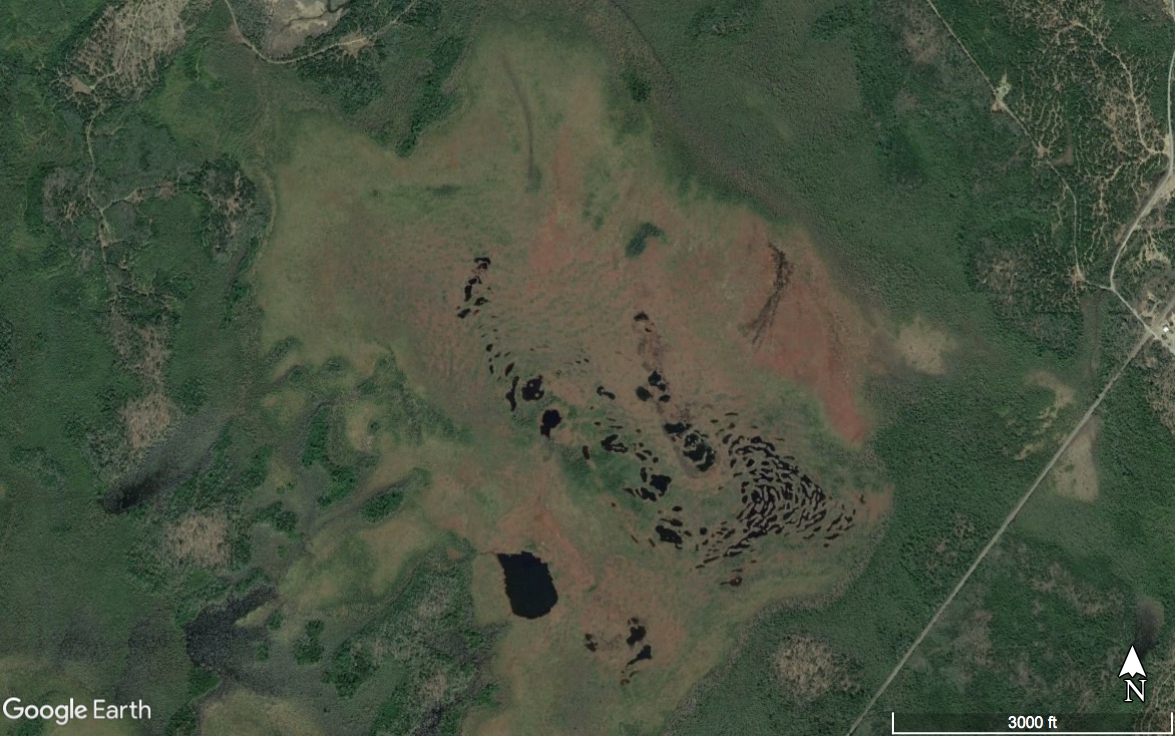
Getting into Crystal Bog (also known as the Thousand-Acre Bog) is not an easy task—a fact I discovered when I first explored it in 2020. No trails enter the bog proper, and the adjacent ATV trails only skirt the extensive swampy thickets that surround it. Choosing the wrong route is easy in such habitat, especially on overcast days when clouds obscure the sun and any hint of which direction might be north or south.
I don’t carry a GPS device or a smart phone, so I navigate via compass when vegetation is too thick and landmarks too obscure to provide orientation. During my attempt to access Crystal Bog in 2020 I rode my bicycle a little too far on the ATV trail that cups the north side of the wetland, started south at the wrong place, didn’t utilize my compass often enough, and bushwhacked much farther than expected or necessary. With those lessons learned, however, I felt better prepared to avoid the thickest muskeg and swampiest areas to reach the open bog more easily.
I locked Rocinante to a sturdy tree once I located a good starting point…

…and set off through the trees.

Crystal Bog is part of a large wetland complex. On every side of it, streams meander through forested swamps and sedge-filled fens. The sphagnum peat lands at the center of this complex was my destination, though.
After 20 minutes of travel (a remarkably short time span compared to the two hours of bushwhacking I needed the previous year), the forest began to transition into a more open woodland. Sphagnum moss and low-growing ericaceous shrubs became common and spindly black spruce and eastern larch were the only trees.
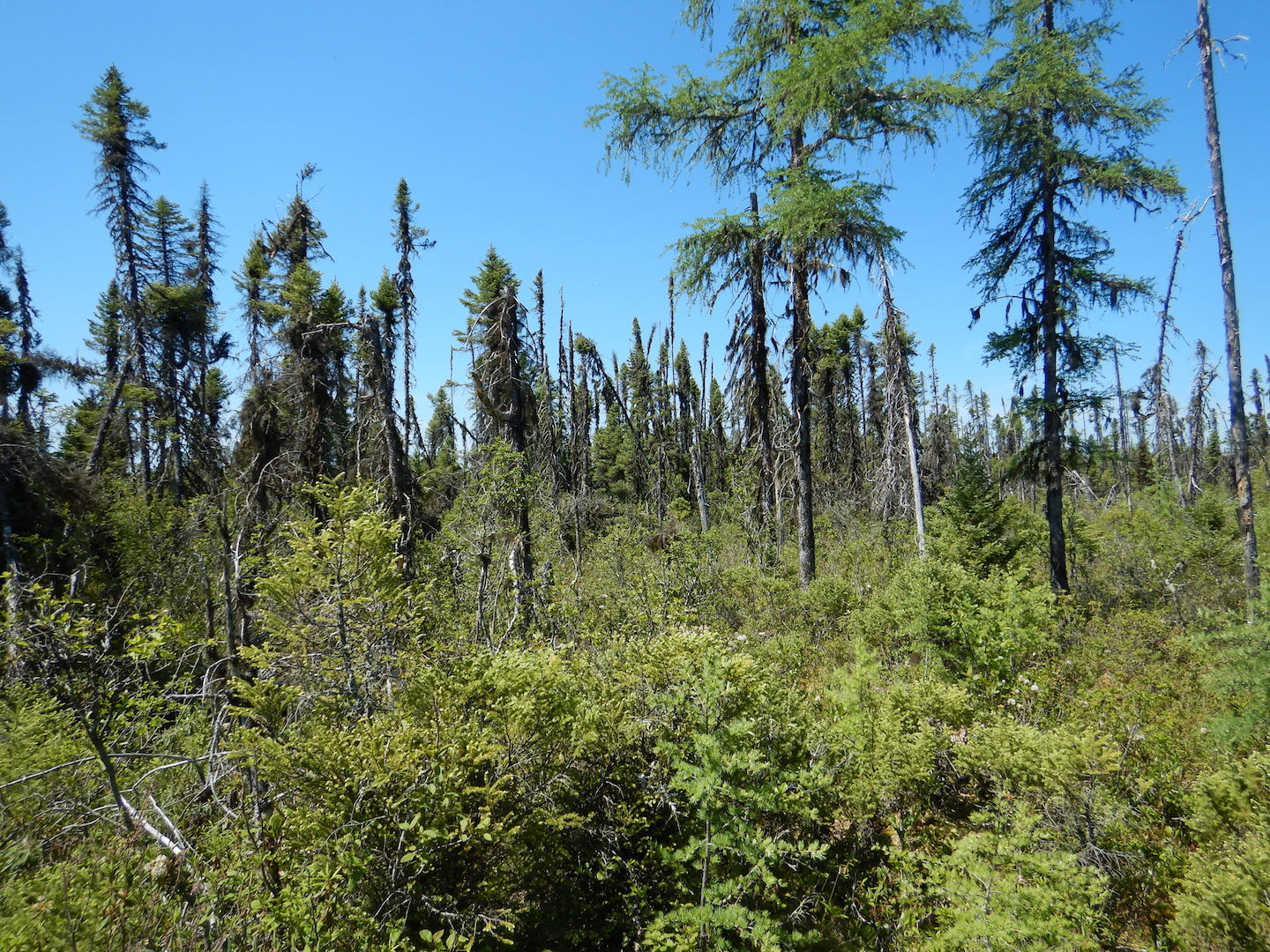
Shortly after, I reached the open expanses of the bog proper.

As I moved from swamp to muskeg to sphagnum bog, I moved progressively into harsher habitats, at least from a botanical perspective.
Bogs are a type of peat-land that generally get water from aerial precipitation rather than flowing surface or ground water. Sphagnum thrives here. The tannins and acids released by sphagnum lower soil pH to levels inhospitable for most plants. While a bog’s edges might be richer in minerals and productivity due to ground or surface water flow, the sphagnum-dominated areas in and around its center offer very different conditions. The pH at Orono Bog near Bangor, for example, progresses from 6.6 (a pH you find in milk) at the forested edge to 3.8 (a pH approaching that of grapefruit juice) at its sphagnum-dominated center. Since the pH scale is logarithmic, rather than linear, this difference represents almost a 1,000-fold change in acidity.
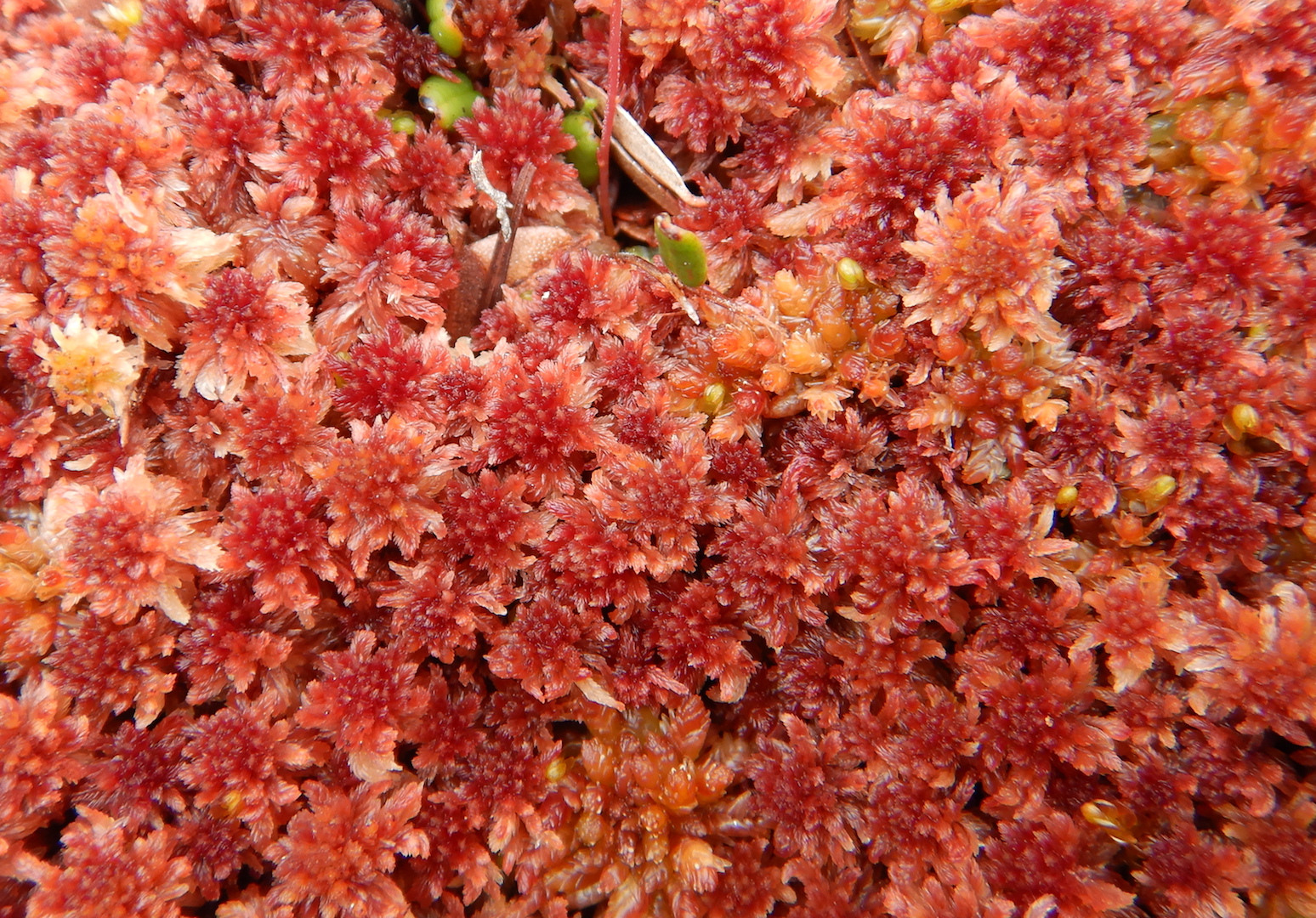
Sphagnum moss
As more sphagnum grows on the surface, it buries and compacts previous generations to form peat. Decomposition is also hindered by the low oxygen conditions found in the bog’s supersaturated soils. But, sphagnum is really good at growing on top of itself. In this manner, sphagnum begets sphagnum. Under the right climatic conditions, sphagnum bogs can sustain themselves for thousands of years and peat accumulations can grow many meters thick. Peat also preserves a botanical record of the plants that lived in the bog and the pollen that settled on it, a paleontological record on present and extinct animals that died within them, and even an archeological record of the people who utilized these places.
On top of this wealth of partial decay exists a living veneer. Minute gradations in topography and drainage create micro-habitats for the plants that are adapted to the bog’s stressful conditions. The higher above the bog’s water table, the more oxygen can diffuse into the soil and the more O2 is available for plant roots that need oxygen. Relatively few plant species survive in bogs compared to nearby forests. Yet those that do are often abundant.
Larch and black spruce in bogs receive ample sunlight, have access to plenty of water, and experience little competition from other tall plants, but the peat enveloping their root systems offers little to sustain their growth. Small-statured trees in a bog may be many decades old, while growing little more than the height of an average adult person. At the Orono Bog, some 7-foot tall spruce trees were found to be about 100 years old. (FWIW a tree, I think, cares not for its appearance, only its ability to reproduce.)

These small-statured black spruce (Picea mariana) may be many decades old.
Ericaecous shrubs such as Labrador tea, bog rosemary, and laurels survive in bogs only where their shallow roots remain perched above the flooded peats and sphagnum. Yet, although bogs are classified as wetlands, summertime drought can cause drastic lowering of the water table. The thick, leathery leaves of these plants might help them retain moisture under those conditions.
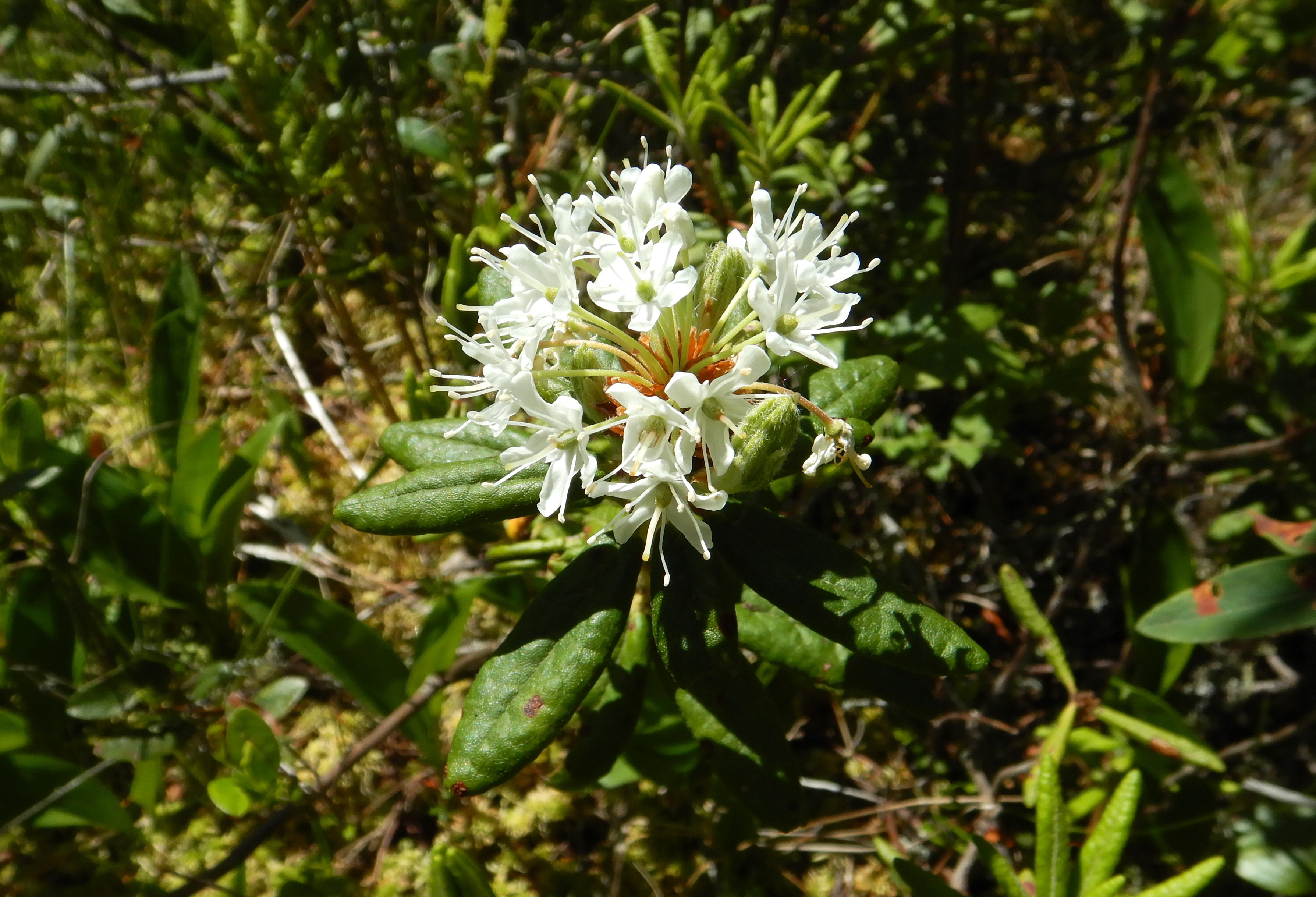
Labrador tea (Rhododendron groenlandicum)
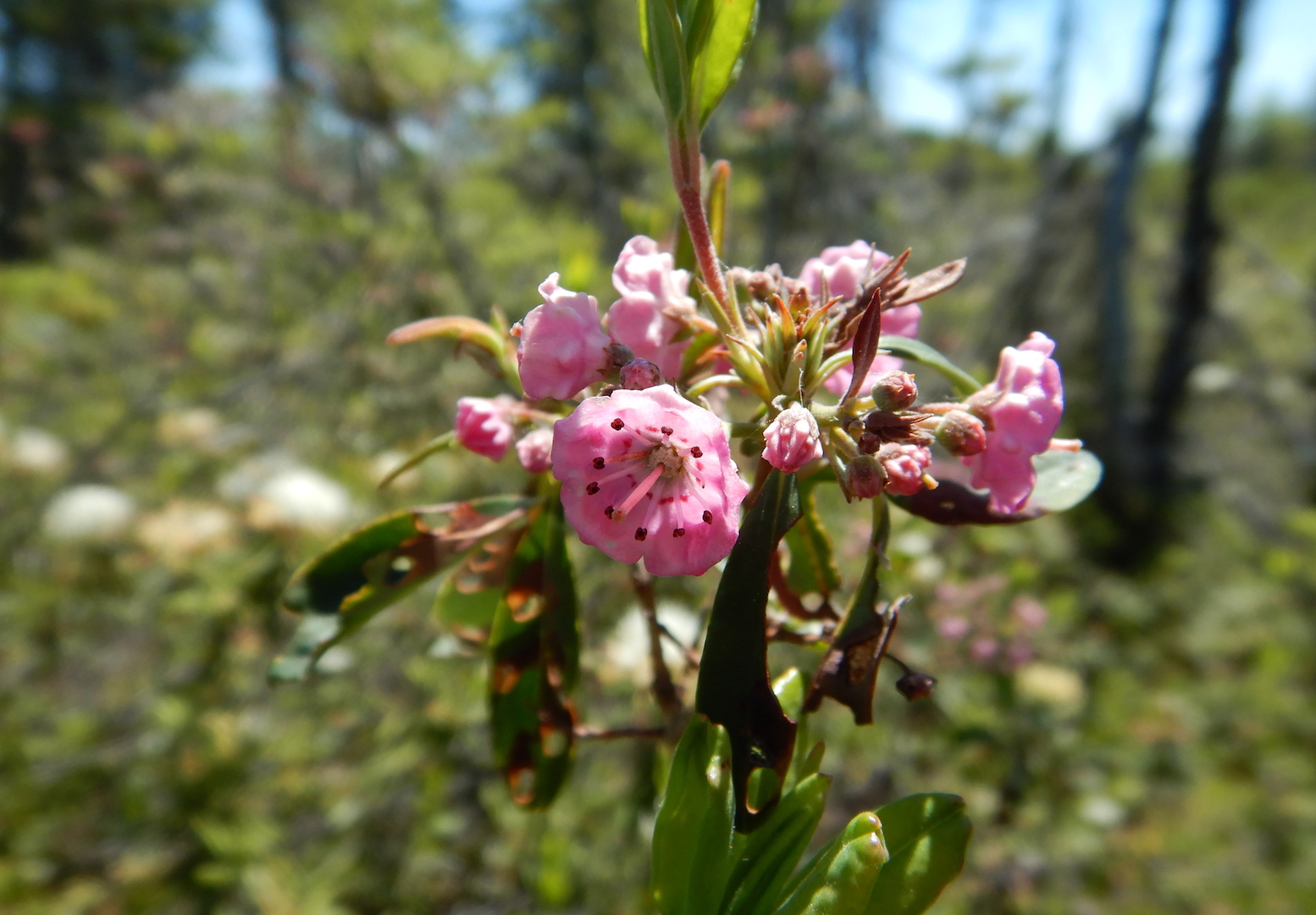
Sheep laurel (Kalmia angustifolia)
Orchids tap mycorrhizal fungi to overcome the lack of nutrients, a trick utilized by the ericaceous plants as well.

Grass pink (Calopogon tuberosus)
Other bog plants evolved means to capture nutrients from animals. Bladderworts capture prey in small sacs attached to their thread-like underwater leaves. When a tiny zooplankton contacts sensitive hairs on the outside of the bladder, it triggers the bladder to inflate. The sudden action sucks in water and the hapless prey. The plant then absorbs its nutrients.

Bladderwort (Utricularia sp.)
Sundews ensnare small insects using sticky secretions on the ends of glandular hairs on their leaves. An insect alights on the leaf and becomes stuck. The hairs and the leaf margins then slowly fold over and envelope the insect. The leaf hairs also release an anesthetic to stupefy the prey as well as enzymes to dissolve its soft tissues.


Round-leaved sundew (Drosera rotundifolia). An unlucky insect is trapped on the leaf in the right photo.
Pitcher plants use specialized leaves to create a basin of water. Insects that fall into the basin, aided by downward pointing hairs on the inside of the leaf’s rim and numbing secretions, are slowly decomposed by bacteria and possibly plant enzymes that live in the water. Specialized cells at the bottom of the pitcher absorb the insects nitrogen and other nutrients.


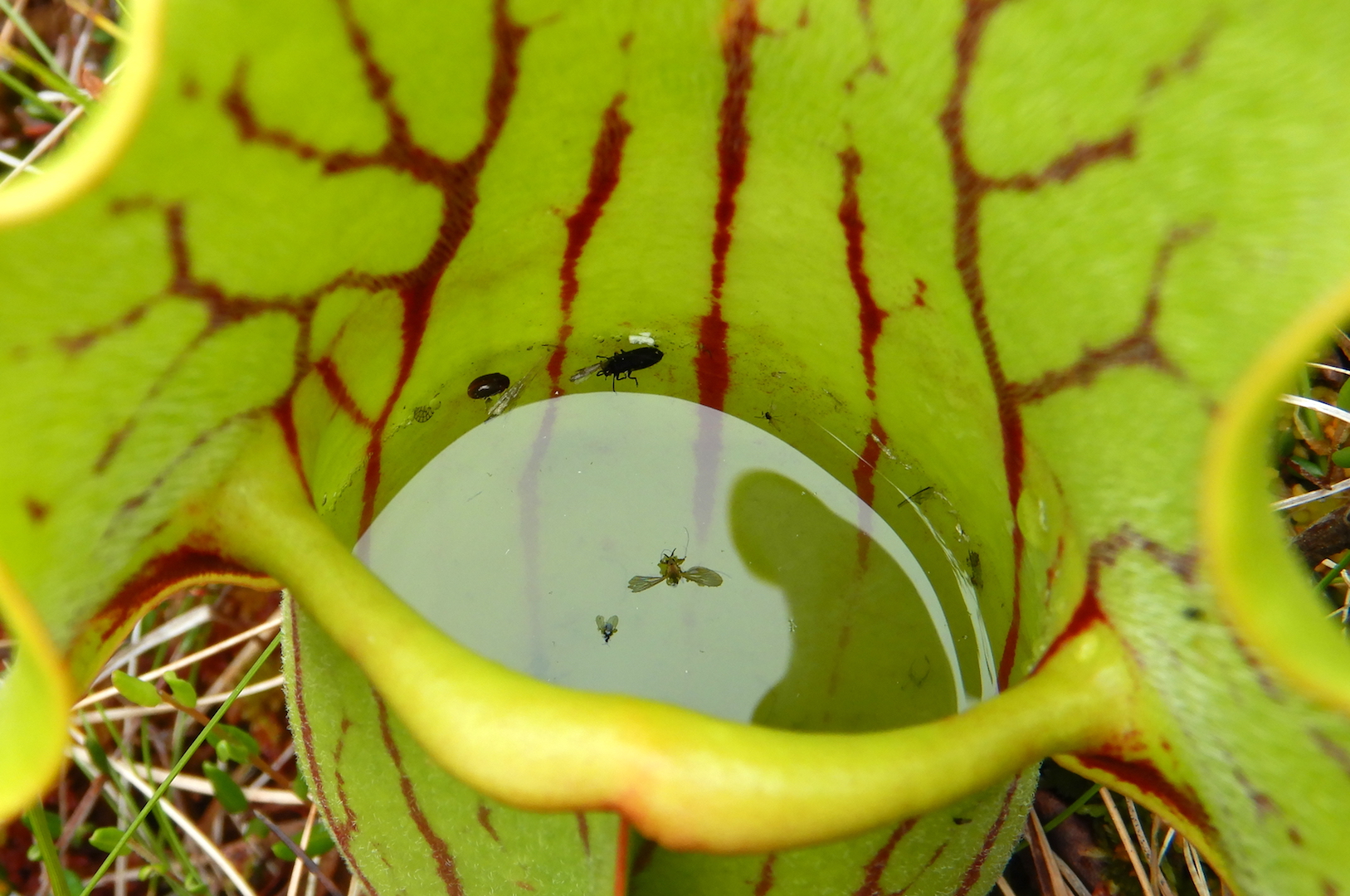
Pitcher plant (Sarracenia purpurea)
I paused often as I wandered through the bog to marvel at the tenacity and beauty of the life around me. I also marveled at the lack of a human presence. The ability to experience a landscape that wasn’t overtly altered by people was a special treat, even in one of the least populated U.S. states.
Maine is lushly vegetated. Forest covers a greater percentage of its land than any other state. That forest, though, is heavily manipulated by people—by a timber industry that often harvests trees before they reach age 50, by a warming climate, by tens of thousands of miles of roads, and by invasive species. But human-caused changes are not limited to the land. Off the coast, the Gulf of Maine is one of the fastest warming bodies of water in the world. There is virtually no Atlantic cod fishery because cod haven’t recovered from the devastation of overfishing in the 20th century. Ditto for Atlantic salmon, which hang on by a thread. Places where evidence of humanity’s heavy hand is absent or at least minimized are difficult to find even in parks such as Acadia, Baxter, and Katahdin Woods and Waters.
Bogs are often overlooked at best or viewed as wastelands to be “reclaimed” for agriculture or mined for peat at worst, but they rank among the worlds most important habitats, especially when we consider their ability to capture and sequester atmospheric carbon. Like old-growth forests, peat is a non-renewable resource since we humans lack the patience and self-restraint to harvest it at sustainable levels (please buy peat-free soil products for this reason).
While the area surrounding Crystal Bog is full of roads, early successional timberland, potato fields, homes, and small towns, this bog remains remarkably unmarred. It is one of the few places in modern day Maine that would be recognizable to a Wabanaki traveler from the 15th century. In the middle of Crystal Bog, it’s easy to let your mind drift to a place where the world is well. This is an illusion, I realize, but one we all must escape into every once in a while.

What a great read. Brought back a lot of memories from my childhood back in Upstate New York. My dad was a conservationist, hunter, fisher, nature lover, and outdoorsman. Growing up we ate what he caught and my dads love of the outdoors rubbed off on me at a very young age. He taught me to fish and we spent many weekends going for rides in the country, picking berries, and exploring. I was like the boy he never had and to this day I am thankful for every minute of it. I was always wanting to walk in the woods or looking in streams to see what I could find. I still enjoy being outdoors, hiking and exploring. I will always be passionate about animals and nature. There is so much beauty all we have to do is look around us. Thank you for sharing this great article. I am also enjoying your book right now as well since our bears and especially Sweet Otis 💕are denning. Wishing you and your family a very Happy and Blessed Thanksgiving😇
LikeLike
What a unique landscape, thank you for the tour and all the information to go along with it!
LikeLike
Very enjoyable read and the pictures add a lot. Thanks again for sharing your adventure and knowledge.
LikeLike
Wooow, thank you! What a gift! (So – plants can be jerks, too??? 😀 ) Now I go google all those new words, while you get stuffed with all the Thanksgiving goodies (of which you deserve every morsel!)
LikeLike